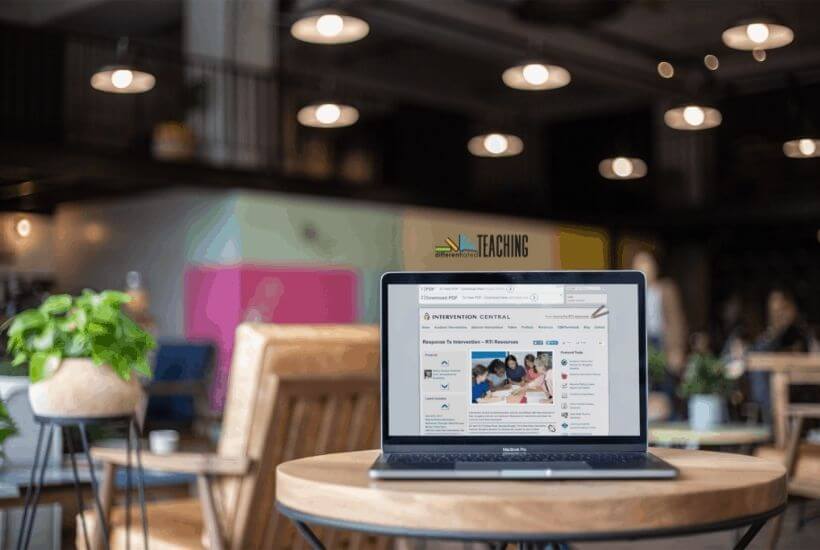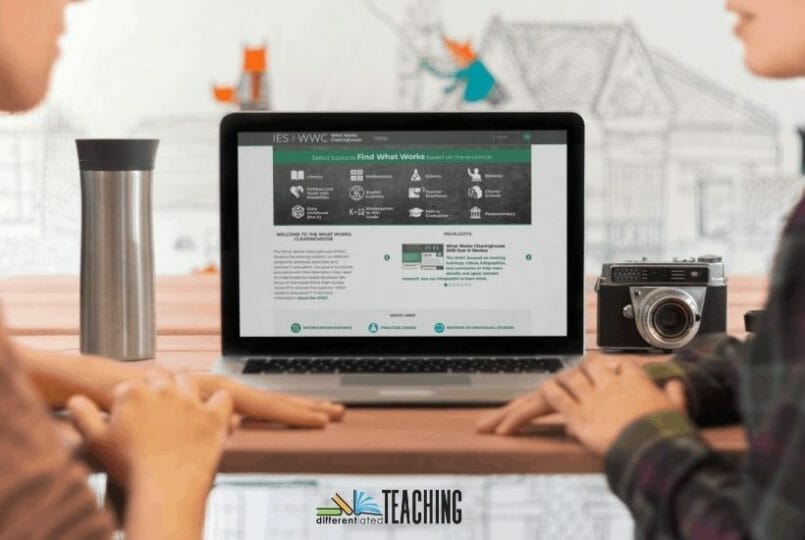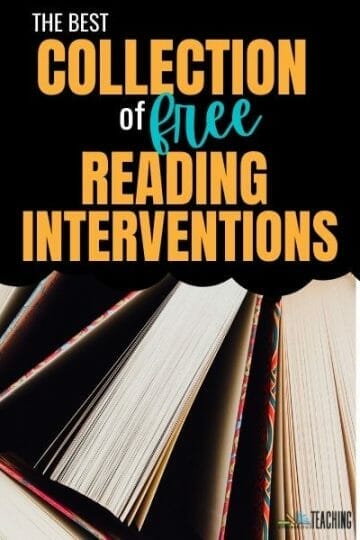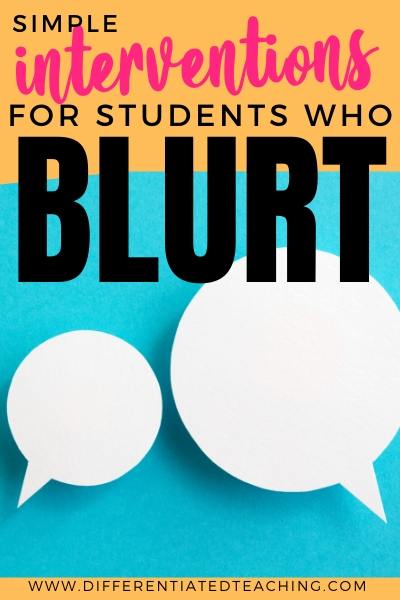10 No-Cost Reading Intervention Programs -Free Websites with Lessons and Tools
Finding great resources to support reading intervention for struggling readers can be challenging. An even bigger challenge is finding inexpensive or free reading interventions that are high quality and fit within your limited budget. The great news is I’ve already done the work for you (because who has time to spend hours scouring the internet for reading intervention tools)?

These ten websites for reading intervention all contain great resources that will help your students build essential skills in the core areas of reading, including phonemic awareness, decoding, fluency, comprehension, and vocabulary.
Free Reading Interventions to Use with Struggling Learners
The websites below have great printable and digital resources for all the core areas of reading, from phonological awareness to comprehension.
1. Florida Center for Reading Research
Target Literacy Components: Phonological awareness, phonics, fluency, vocabulary, and comprehension
Tools for tutoring or intervention with a struggling reader? You must go to this site. Broken down into the five different components of literacy, this site has lessons, games, and resources for all your reading intervention needs.

The student centers are great targeted activities for skill-building. These are broken down by grade level. There is a K-1, 2-3, and 4-5 set of centers for each reading area.
Just print, and you are ready to teach. It is seriously a one-stop shop for reading.
Visit the Florida Center for Reading Research site.
2. West Virginia Phonics
Target Literacy Components: Phonemic awareness & phonics
This is the site if you’re looking for great free reading interventions for phonics. This is a very popular (free) phonics curriculum that is both sequential and multisensory. It is great for building decoding skills from the most basic level all the way through those tricky multi-syllable words.
The curriculum has 10 skills, each with multiple lessons focusing on a different core phonics skill.
The downloads include clear, well-laid-out lesson plans. You can use them to teach decoding to struggling readers explicitly. In addition, they include word lists and practice resources for each phonics pattern.
Access the West Virginia Phonics Curriculum.
BONUS – Video Lessons are Now Available
The Mississippi Department of Education converted these lessons into shows! Find them all on their YouTube Channel here.
3. Spel-lang Tree Word Study Program
Target Literacy Components: Phonics, vocabulary, spelling, grammar
This great free resource offers multiple levels of support for kiddos from preschool up.
The tree-themed progression begins with Seeds and has three teachers’ manuals to choose from based on your learners’ needs. Each manual clearly outlines lesson plans and has student printables.
Here’s what you’ll find in each level of the program:
Seeds – Targets pre-k through first and focuses on the foundations of sound-symbol correspondence. It includes visuals, literature connections, enrichment activities, games, and word lists.
Roots – This level addresses first graders or struggling learners who have not mastered sound-symbol relationships. The Roots scope & sequence covers phonics, handwriting, and grammar. The lessons are 20 minutes and can be used in classrooms or homeschool settings.
Trunks – Targets second graders or those needing support with advanced phonics and grammar skills. Students study syllable patterns, learn more about word families and begin working more deeply on grammar skills. Phonics skills include silent letters at this level. The system includes a robust plan for formative assessment to guide your instruction.
Visit the Spel-Lang Tree site.
4. Helping Early Literacy with Practice Strategies (HELPS)
Target Literacy Component: Fluency
HELPS is an evidence-based early reading program that targets fluency. According to its creators, the program aims to help students improve their confidence as readers by increasing their ability to access text fluently.

The HELPS site offers teacher training videos and a free download of their program, which includes over 100 fluency passages. It’s designed to be easy to implement and can be used by teachers or homeschool families to boost fluency.
HELPS has been recognized by What Works Clearinghouse as significantly improving word reading, fluency, and comprehension.
Learn more or access the HELPS materials here.
5. SERP Institute
Target Literacy Component: vocabulary, comprehension, basic reading
SERP is a research institute focused on improving educational outcomes for older students. They’ve got two reading programs available on their site at no cost. Below is a quick overview of each:
WordGen – Available for Grades 4 and up, WordGen focuses on content-area literacy. There are 12 two-week units included in the program. Lessons are a bit long for most elementary intervention periods but are designed for middle school blocks of 40-50 minutes, so you’ll likely have to break them apart if you’re working with upper elementary learners. They have separate programs for both Elementary & Middle schools.
STARI– This is their Tier 2 adolescent literacy program designed for grades 6-9 students who are reading 2+ years below grade level. It has nine units and is designed to connect to authentic reading experiences. Reading materials include novels, short stories, nonfiction texts, and poetry. The STARI materials can be found here.
Visit the SERP Institute site.
6. Lalilo
Target Literacy Component: phonics & comprehension
Lalilo is a free web-based intervention for students working on skills that are K-2nd grade level. The digital format is great because it is adaptive and allows for individualized work based on where the student struggles.
Target skills include phonics, word recognition, and comprehension. The site is fun for learners because the creators have gamified the experience of learning foundational reading skills. Students work their way through a number of worlds and collect badges and stories while doing so.
The vocabulary is rich and targets topics of interest to many students – nature and animals!
On the back end, you’ll find that you get access to data that can help you monitor progress and inform your instructional decision-making.
7. ABeCeDarian
Target Literacy Component: phonics & vocabulary
The ABeCeDarian program is a research-based reading program aligned with the science of reading. They are currently updating and adding to their curriculum, but at the present time, there are four levels available.
All four levels offer free workbooks, teacher lesson plans, and supplementary materials. Here’s a quick overview to help you determine which you’ll need for your learner:
Level A
These materials are best for non-readers or those beginning their reading journey.
Lessons target phonological awareness, sound-symbol correspondence, and the foundations of reading and spelling. Ten decodable readers are included in this level. By the end of Level A, students will have a bank of more than 100 words they can read fluently.
Level B
Once students reach Level B, they’ll work on more complex phonics skills. They’ll begin learning about vowel pairs and spend time on phoneme-grapheme correspondence.
The level includes fluency building with these new patterns and offers strategies to help students begin to decode multi-syllable words accurately. Level B is best for on-level students in grades 1-2 or struggling learners in upper elementary.
Level C
This level begins to focus more on morphology. Students learn the most common prefixes and suffixes and their meanings. They begin to look at spelling patterns more deeply as well.
Level C is for on-level 3-4th grader readers. Depending on their gaps, it would be an excellent option for struggling students in late elementary or early middle school.
Level D
This level is an advanced word study. It would be unlikely to be helpful for elementary learners needing intervention. Targeting 5-6th graders who are on-level, this level might be a great fit for your later middle school or high school level reading interventions.
The resource targets Greek roots. Exercises are fast-paced and designed to help students learn the meaning of these roots and their spelling.
Learn more or access all four levels of the ABeCeDarian program here.
8. WordSpring
Target Literacy Component: phonics & spelling
First, you’ll need to understand this tool is slightly different than others on this list. It won’t do all the heavy lifting for you regarding intervention planning. However, if you’ve got a good foundation and just need a simple way to gather and build out your intervention plan or create a wordlist for a certain pattern, this is a huge help.
A downloadable scope & sequence is available, but even with this resource, I wouldn’t consider this a great fit for beginners. Despite this, it has some great options for teaching reading, spelling, and penmanship for struggling or at-risk learners using the well-respected Orton-Gillingham method used in quality dyslexia programs.
9. Hall County Schools Literacy Interventions
Target Literacy Component: phonological awareness, phonics, fluency, & comprehension
Despite heavily leaning toward Balanced Literacy, this site out of Georgia has some great tools for reading intervention. One advantage is that you can find and download resources based on the components of reading.
The lessons shared on the site are super quick to read and easily implemented, and there are some great forms for documentation. That said, it wouldn’t be my first stop on this page.
Learn more or access the resources now.
10, Free Reading
Target Literacy Components: print concepts, phonological awareness, phonics, comprehension, fluency, vocabulary, and writing
The Free Reading site is clean and simple, which makes it easy to find exactly what you need quickly and easily. It has some great Tier 1 intervention options, and the materials are all broken down by the different literacy components.

However, don’t use this one only as a free reading intervention resource! The “Find Activities” tab allows you to pick and choose between different areas to suit your needs. The Teaching Tools tab has a week-by-week plan for literacy interventions.
Super easy to use and teacher-friendly.
Head over to the Free Reading Website.
More free reading intervention tools for your classroom
While the above tools offer a more comprehensive look at reading intervention, I’ve also found some great resources to help you plan and design support for your learners.
Research-based literacy intervention strategies on Intervention Central
If you’re looking for strategies more than programs, Intervention Central can be a good resource. However, unlike many other resources I’ve shared, this one will take a little more time to dig through, read, and process.

The site highlights good alternatives for whole-class interventions. These can help support students who have been out of the school routine for a few years due to Covid changes.
Additionally, the interventions shared on the site are all evidence-based, free reading intervention strategies. Step-by-step implementation plans are clearly outlined. Plus, they’ve included research citations. You can use these to document the research-based strategy you’re using.
Program evaluation and support for decision-making from What Works Clearinghouse
If your district has the money, but you’re struggling to determine which interventions are best for your student population, this resource is for you.
What Works Clearinghouse has an easy system to help you determine which evidence-based interventions can help you get the most bang for your buck…and which to skip over.

Since salespeople can be EXTREMELY persuasive when they come knocking at your district, it’s important to do your own research and make sure you’re getting the best program possible for the needs you are seeing.
First, the “Find What Works” tab lets you search by topic (in this case, literacy). Then you can examine the research evidence supporting nearly any program or intervention your school might consider.
However, this site is not for the newbie interventionist, but if you have some research methods and stats background, you cannot find a better resource.
Documentation for guiding the RTI process for learners
If you need something to help you with all the organizational pieces, Building RTI out of the University of Texas is a great site.
Created in 2016, it has a number of amazing resources, including some for Tier 1 classroom instruction and interventions. Campus-focused resources are also available.
This site has everything from parent information letters to graphs and data organizers. I could spend hours just wandering around reading what I find. They’ve got ready-to-go models and materials. Plus, it is free!!
They’ve even got continuing education courses for teachers. You’ll want to check with your campus or district to ensure you can get the CEUs for your choices, but they are something to check out.
Even more free tools for documenting classroom Tier 1 interventions & preparing for a Student Support Team Meeting
One major issue when it comes to intervention is having the documentation needed for the Student Support Team. Therefore, it’s important to ensure you’re keeping track of the interventions occurring in the classroom using data.
Even if you’re an interventionist rather than a classroom teacher, there are a number of simple strategies you can share with your campus that can improve the data collection and reduce the stress teachers feel when they come to your campus meetings.
Here are a few ideas to share: Documenting Tier 1 Interventions in the Classroom
Free tools for communicating interventions & supports with parents
Classroom teachers and interventionists also need to be keeping families in the loop when their student is struggling and receiving extra supports. This doesn’t have to be time-consuming or stressful, and it can reduce the number of phone calls you get when report cards come out.
You can access some free resources to help you communicate with parents on this article.
These free reading intervention resources will get you started as you plan to support for the struggling readers in your classroom or in intervention groups this year.

Know of another great site I should add to the list? Leave it in the comments below! In the meantime, you can check out these great articles to help you find more resources to support your learners.






